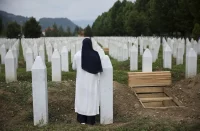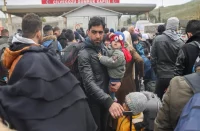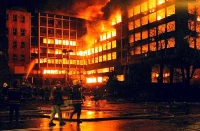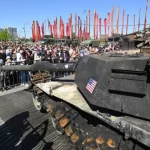Territory, people, and physical power (security forces like police and army) are the inevitable prerequisites for creating a state. The ethnic Albanians were at the beginning intruders into the autonomous province of South-West Serbia – Kosovo-Metohia (KosMet), who constituted a small minority there (in 1455 only 2%). The focal question became: How it happened they became the overwhelming majority today (95%) at KosMet?
KosMet: The “Promised Land” for Albanian migrants
As it is a historical fact, migration of the highlanders to lowlands appears a constant feature from prehistory to the present day. If both sides belong to the same ethnicity this phenomenon remains within the socio-anthropological sphere. But, if highlanders are of different ethnicity, this otherwise natural phenomenon acquires features of the clash between nations. This clash may end in bloody fighting and a state of war. That is, in fact, what happened in KosMet.
The Albanian presence at KosMet during the medieval Serbian state, under the Nemanjics dynasty (1166−1371), was virtually zero. In the famous Serbian Emperor’s Stephan Dushan juristic code (the Codex of Dushan) from 1349/54, they are not mentioned at all.[i] A number of paragraphs are dedicated to the right of nomadic herdsmen, who are allowed to stay in a village for two days at most. These montagnard herdsmen were called the Vlachs, who were supposed to be of Dacian (present-day Romanian) origin. Some of them might be ethnic Albanians, who moved their herds from highlands to lowlands and vice versa, according to the season.
The first recorded presence of Albanians at KosMet appeared only in 1455, in the Ottoman cadastre (defter), which gives the figure of only 2% ethnic Albanians in the region. But, afterward, numerous organized migrations from the territory of the present-day High-Albania have been recorded, both towards inner Albania and KosMet apart from the Ottoman settling Muslim Albanians at KosMet after the 1689 Serbian uprising against the Ottoman authority. There is a record due to the Roman-Catholic Bishop from Skopje, Matija Masarek, who reported in 1764 to the Vatican that brand-new colonies of Albanians from High-Albania were founded around Djakovica in Metohia (western KosMet) nearby the present border between Serbia and Albania. Serbian historian Jevrem Damnjanovic finds that during the Ottoman Empire, members of the following tribes (or fisses in Albanian) were settled on KosMet: Dukagjini, Bitiqi, Kriezi, Shop, Berisha, Krasniqi, Gashi, Tsaci, Shkrele, Kastrati, Shala, Hoti, and Keljmendi.[ii] Before the migrations during WWII which drastically changed the ethnic composition of the region in Albanian favor, when KosMet’s biggest portion was a part of a “Greater Albania”, under fascist Italy (1941−1943) and Nazi Germany (from September 1943 to autumn 1944), there were constant migrations from North Albania to KosMet too. Here is what the Albanian historian Peter Bartl writes on the subject:
“The Turkish conquests influenced spreading out Albanian settlements. In the Turkish time, an increase in the number of the Albanian population was especially considerable in Kosovo.
Already by the end of the 13th century, begins the immigration of the Albanians from the surrounding mountainous regions to Kosovo. Among miners mentioned digging silver in the rich mines in Kosovo were also Albanians. During the Turkish conquest (1455) the Albanians comprised already 4−5 % of the overall population…”[iii] (in fact, only 2%).
This increase of the ethnic Albanian share of the overall population in KosMet was followed from the beginning of the 20th century by the demographic explosion. The birth rates of Albania’s Albanians, KosMet Albanians, and KosMet Serbs and Montenegrins as a function of (historic) time are presented in the book Serbs and Albanians Through Centuries, by Petrit Imami, an Albanian author from KosMet, published in 1998 and transmitted in Belgrade liberal and pro-Western daily Danas. According to P. Imami, from 1950 onwards, both populations KosMet’s Serb and Montenegrins and Albania’s Albanians have been decreasing – the first double more compared to the second. However, in the same period, KosMet’s Albanian population was in drastic increasing up to 1980. These facts deserve close examination.

The first notice is that Albania’s Albanians and KosMet’s Serb’s curves follow the same trend of decreasing, though they differ in absolute values.[iv] The curve for the KosMet Albanians behaves radically different from both, however. It reaches a maximum around 1960, retains this maximum up to 1980 and starts falling down. Why 1980 was the “turning point”? Before attempting to answer this puzzle, a few preliminary words are in order.
Josip Broz Tito as a godfather
A Croat-Slovenian dictator of Yugoslavia, Josip Broz Tito (1892−1980), was the seventh of 13 siblings, in a relatively poor peasant family in Hrvatsko Zagorje, a rich Pannonic region in North-West Croatia nearby the Slovenian border. His youth was marked by poverty and he will suffer from a number of complexes in his later life. One of them was the lack of good suits. When he was a metal worker in Zagreb, he saved some money and managed to buy a new suit, he intended to wear while visiting his birthplace Kumrovec. Unfortunately, just before leaving for his village, he found his brand new suit stolen and gave up his visit. Upon seizing power after WWII, he used to have his new suits made once a week or so, just to compensate for traumatic experiences from his youth.[v] Equally, he was somehow ashamed of his numerous siblings, as a sign of poverty. Therefore he established the institution of awarding numerous families, by appointing himself godfather to every tenth and following child in his Yugoslavia (Titoslavia). Of course, he delivered the award via his representatives, usually, high-rank officers and many families were proud of having Marshal Tito their godfather.[vi]
However, the question rises who were the beneficiaries of this gratitude? By far the most frequent recipients were ethnic Albanians and Roma. There was some difference between these two groups, however. Roma children suffered from high mortality, for reasons we do not have to elaborate on here. Thus, the enormous birth rate of the Kosovo Albanians not only was not put to reasonable control but was encouraged by the very state authorities. The fact was that the Serbs had higher birth rates than Albanians before KosMet was recovered by their motherland, Serbia. With re-joining Serbia in 1912/1913, it came better medical care and the high mortality rate, present among all Dinaric highlanders was drastically reduced. The response of the Serb population to these better conditions and to the rising level of civilization generally was the introduction of family planning. Nevertheless, with the (Muslim) Albanians it was the opposite case. They took an advantage of better medical facilities to promote further the breeding rate.
“Demographic pressure” and demographic change
Another point that deserves to be made concerns the correlation between economic conditions and fertility. Generally, high fertility signalizes the low economic status of a family.[vii] Albania’s Albanians were definitely below Kosovo’s Albanians in this respect but had a lower birth rate than the latter. Obviously, other factors were in-game. The same holds for the Serbs, too.
Now it has to be turned to the crucial point of the entire “Kosovo issue”, to the ethnicity share on KosMet from the early Serb state, through the Ottoman occupation to the present day. It has to be noted here that the first record on the subject is from the 14th century, from the so-called Dečani hrisovulja (1330),[viii] which contains a detailed list of houses in Metohia and North-West Albania. Out of 89 villages, 3 were Albanian. There were 2.166 agricultural households and 2.666 houses in the cattle cultivating area. Out of this number 44 were Albanian (1.8%). The rest was recorded as Slavonic, which is a Serb.
According to the data by Kosovo’s Albanian writer Petrit Imami (1998), in the region of KosMet there were 50% of Albanians and 40% of Serbs (and Montenegrins). However, in 1985, there were 12% of Serbs while in 1995, there were 85% of Albanians. He claims that in 1455, there were less than 3% of ethnic Albanians in KosMet. The point from 1455 was taken from the Ottoman cadastral for tax-census (defter) (Original is in Turkish in an archive in Istanbul).[ix] The latter kind of record is notorious for its accuracy and scrupulousness, as Al Capone found to his misfortune. As for the 20th-century data, oddly enough they turn out rather unreliable, for various reasons. First, when KosMet became a “disputed land”, the sides involved started the war by the numbers, producing them as they found convenient to their “just cause”. Second, since this region was outside a civilized state for centuries, administrative control was very weak, if even not absent. It is known that the Balkan Dinaric highlanders had never feeling for the state as an institution, nor felt they much responsibility towards the state and her authorities. In particular, during the census, many numerous families, expecting to get help from the state, or at least to get some tax reduction, used to quote an excessive number of children. It is the notorious fact that the KosMet Albanian population was greatly overestimated in these censuses. When Serbia undertook the census in 1981, it was prevented on KosMet by the local riots. Hence, every statistic figure offered for KosMet must be taken with a grain of salt, indeed.
Bearing the latter in mind, the question is: What was the cause of such a steady rise of the Albanian share in KosMet presented by Petrit Imami? Two principal reasons are known: 1) Constant (illegal) migration from North Albania; and 2) The high birthrate, which passed into a demographic explosion after WWII. This caused a “demographic pressure” onto the non-Albanian population, practically the Serbs (including and the Montenegrins), who were forced in one way or another to move from the region, mainly to Central Serbia. All effects combined gave rise to emptying KosMet from the non-Albanian population and a steady increase of Albanian share, as Petrit Imami presented.
Problems with “Gray economy”
In the intense propaganda, skillfully controlled by KosMet’s Albanian politicians, KosMet has been considered a very poor region by the international community. However, the focal question became: Is this picture realistic, or is it the product of somebody’s wish to make political profit from this misconception? It is, in essence, the latter case, uncritically accepted by the external factors.
For the matter of very facts, KosMet possesses very fertile soil, almost as fertile as that in the Pannonic Plane (Vojvodina in Serbia and Slavonia in Croatia). Since 4/5 of the population lives in rural areas, this fact is of no small importance. However, in assessing the economic welfare of the province, one must account for many relevant items. It is clear in modern society that reality is the information. That is why it appears so important to control public media, both in liberal and autocratic societies.
Normally, all relevant parameters destined to characterize a country or a region, are expressed per capita. In the standard case (like the European region) these parameters appear realistic indicators of the true state of the art. But in the situation of the demographic explosion, two things must be born in mind:
- First, it is the item per family that is more relevant, for the entity per capita may be very deceiving.
- Second, in the same situation, the temporal dimension must be accounted for.
In the case of a large natality rate, the usual quasi-static approximation is quite inadequate.
 Another important distinction must be made in estimating the economic wellbeing of a region. As in any country, there is always, apart from the official, legal economy, the unofficial, illegal one, usually called “gray economy”. Every state tries to reduce the latter as much as possible, if for nothing, then for taxation purposes. The state budget is filed by the legal economy and all public expenditures like an army, education, health, infrastructure, etc., are taken from the budget. The problem with the “gray economy” is the same as with other illegal affairs, like drug smuggling, robbery, murders, corruption, etc. They may be just estimated, otherwise they are not illegal if a rigorous account of the money traffic is possible. Every region with a weak state as an institution is understandably suspect as subjected to illegal activities. This is exactly the case with KosMet.
Another important distinction must be made in estimating the economic wellbeing of a region. As in any country, there is always, apart from the official, legal economy, the unofficial, illegal one, usually called “gray economy”. Every state tries to reduce the latter as much as possible, if for nothing, then for taxation purposes. The state budget is filed by the legal economy and all public expenditures like an army, education, health, infrastructure, etc., are taken from the budget. The problem with the “gray economy” is the same as with other illegal affairs, like drug smuggling, robbery, murders, corruption, etc. They may be just estimated, otherwise they are not illegal if a rigorous account of the money traffic is possible. Every region with a weak state as an institution is understandably suspect as subjected to illegal activities. This is exactly the case with KosMet.
However, here we are not interested in the criminal side of illegal things. The matter we are going to deal with is legal, but out of control of the fiscal authorities, at least to some extent. KosMet is characterized by a very high percentage of unemployment. The estimate goes to 50%, but the exact figure is in question. This percentage appears a direct outcome of the youth of KosMet’s Albanian population, which is the highest percentage of teenage people in Europe. This large share of the unofficial economy makes the standard analysis of the state of art much inappropriate.
A large proportion of the KosMet Albanians work in the countries of West Europe (especially in Switzerland and Germany). These industrious people save almost all they earn and bring it home.[x] This money is then used for private welfare and business, including buying new land. Nothing of this private income goes to the state funds and is nonexistent for the state or regional budget. If one combines this effect with the population of Albanian rural families, one easily understands the failure of the official statistics to provide a real state of affairs.
When the open hostilities in KosMet started in 1987, London Economist published an article emphasizing the poverty of KosMet, as an indication that Serbia’s authorities in Belgrade allegedly did not care for this province. However, if it is compared the average income per family in KosMet and the rest of Serbia, someone would find no difference in the average income. But the politics of the Economist, as it was the politics of other Western mainstream public mass media means (and still is) that the “KosMet issue” remains strictly controlled by the “high politics” and was not on the “public market”.
To be continued
Reposts are welcomed with the reference to ORIENTAL REVIEW.
[i] See the text of the Codex in: Никола Радојчић, Законик цара Стефана Душана 1349. и 1354. године, Београд, 1960.
[ii] In Albanian, “l” is pronounced as “ly”, as in William. The Albanian language has no phoneme for “l”. Letter “q” is pronounced as “ty”, as in Italian ciao.
[iii] Peter Bartl, Albanian. Vom Mittelalter bis zur Gegenwart, Regensburg: Verlag Friedrich Pustet, 1995.
[iv] The KosMet Serb birth rate before the 1998−1999 Kosovo War was considerably higher than in Central Serbia.
[v] About the psychology of Josip Broz Tito, see in [Владимир Адамовић, Три диктатора Стаљин, Хитлер, Тито: Психополитичка паралела, Београд: Informatika, 2008, pp. 445−610].
[vi] About Tito’s biography, see in [Перо Симић, Тито: Феномен 20. века, Београд: Службени гласник, 2011].
[vii] Here it is referring to the self-supporting families, in the bourgeois society. Cases as Maria Teresia (the Habsburg Empress), who had 13 children, who were taken care of by nurses and a host of other relevant servants, are out of the scope of this analysis.
[viii] An official document with a golden seal. Here it refers to estates given by the kings and other rulers to the monasteries.
[ix] This is an estimate. According to the record for the Drenica region, where there were 1873 Serb and 10 Albanian households. Translated text of the original defter from 1455 to Serbo-Croat language is published in 1972 by the Oriental Institute in Sarajevo.
[x] They also used to work in Central Serbia, in particular, the metropolis before the political clashes in the 1990s.














– How it happened that serbs didn’t existed before 8-9 centuary in Illyrian Penninsula ( aka Ballkan ), and how do you explain the fact that the name Beograd is used before for Albanian city of Berat nowadayz??
The Serbs are ancient Illyrians – the oldest people in the Balkans. Albanians came from the Causasus to Balkans only in 1043. Berat-Beograd is ancient Serbian town.
What else can you say about Epirots?
Only 1% clean race of Illyrian allready exist nowadayz, and that’s clearly nor serbs nor greeks. Contraversial theory mentioned, even though Albania of Caucasis is the first state who adopted christianity brings up to the point that they may have been of arian race (as they collapsed after council of Nicaea vs council of Sirmium) same for some indian tribes, which by spoken language are rough but at the same time they differ by dialect of spoken. In Epirus Nova and Vetus, including Dardania we have the same problem in our era and it will exist on the future. But this just approve non-sllav language, non-greek language. Neither you cannot deny that montenegris were firsly created by 30 tribes mostly albanian and boshnjak. In case with greeks, you cannot deny that their independance were the product of arvanites war in cooperation with local greeks until only Morea and Crete were recognised as greek state.
So therelation is from pelasgian, who ruled ancient Europe, to Illyrian who ruled the Illyrian Penninsula up to Morea (including Doric recapture of “Greece” due to a continue of Trojan-Greek war), to Scanderbeg until Great Powers wrong decissions in making the same division as Byzantine-Roman Empire in 1878 with Albania’s natural borders.)
And the final point is religion, in which I can say that the example of St. Bartholomew and not St. Peter in statecraft at the time they have existed, we have Illyrian Albanopolis mentioned in writings, and the content say that they were pagans in mentality. That have been the difficulties all they have had in Albania including Byzantine E., Ottoman E..
The solution: give albanians what belong to albanians, same as for the Cesar in singular.
– In no way is this text an exprresion of historicism used as ethical method.
You have to research this website and you will find my article on Albanian ethnogenesis. This is what I can answer you.